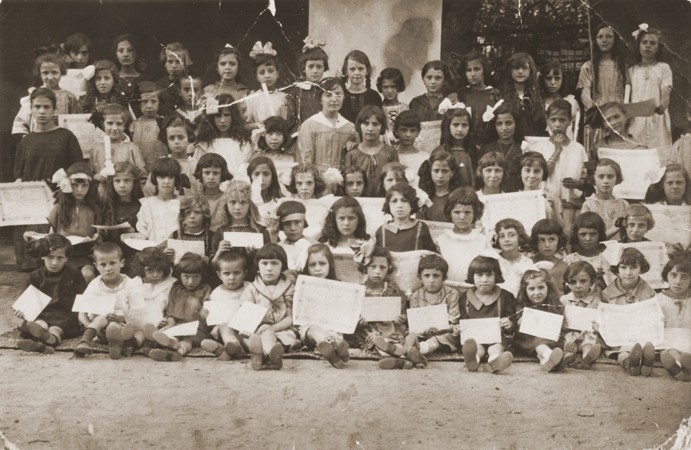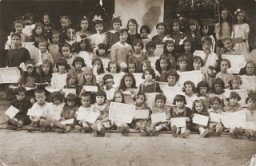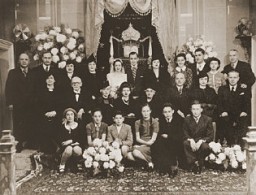
Jewish Community of Monastir: A Community in Flux
The Sephardic Jewish community of Monastir, historically the largest Jewish community in Macedonia. The Jews who trace their ancestry to the Macedonian city known since 1913 as Bitola continue to call the city by the name it bore during centuries of Ottoman rule: Monastir. The final chapter in the history of the Monastir Jewish community came in 1941, when the Germans invaded Yugoslavia and Germany's ally, Bulgaria, occupied Macedonia.
-
1
Bulgarian authorities transported the entire Jewish community to a transit camp in a tobacco warehouse in Skopje.
-
2
From there, the Monastir Jews were deported to Treblinka between March 22 and March 29, 1943.
-
3
Not one of the 3,276 Monastir Jews deported to Treblinka survived
Background
Although Jews had lived in Monastir from Roman times, the Sephardic Jews, who originally migrated from the Iberian Peninsula in the fifteenth century, became the predominant group in the town by the sixteenth century. They maintained a highly traditional and distinctive lifestyle characterized by residence in a Jewish quarter, attachment to the Judeo-Spanish (Ladino) language and Sephardic folklore, commitment to Jewish religious observance, and allegiance to Jewish communal institutions including synagogues, religious schools, religious courts, and mutual aid societies.
In 1863, after a fire destroyed much of the Jewish quarter, the community turned to the Jewish world's leading philanthropist, England's Sir Moses Montefiore, for assistance in reconstruction. This appeal to the West marked the beginning of the Sephardic community's reorientation toward European culture and the gradual introduction of secular education and values into the population. These changes took place at the same time as new transportation links to Salonika expanded trade and brought economic prosperity to the Monastir Jewish community.
Before World War II
This period of cultural and economic development was cut short by political upheavals in the region, beginning in 1903 with the Macedonian rebellion against the Turkish rulers of the Ottoman Empire. Ethnic violence among Greeks, Serbs, and Bulgarians over the future of Macedonia exposed Monastir to political violence and economic disruption throughout the first decade of the twentieth century. As a result, thousands of Jewish Monastirlis (as the locals referred to themselves) emigrated to North and South America, Jerusalem, and the Sephardic metropolis of Salonika. After the end of the Second Balkan War in 1913, formerly Ottoman Macedonia was carved up among Serbia, Bulgaria, and Greece.
Monastir, then renamed Bitola, was in the territory incorporated by Serbia. However, the Jewish community continued to call the city by the name it bore during centuries of Ottoman rule: Monastir.
Jewish Community of Monastir At the turn of the twentieth century, Monastir's Jewish population reached nearly 11,000, but by 1914 years of emigration had reduced the community to just over 6,000. During World War I, Monastir suffered two invasions and two years of bombardment. More than 5,000 Monastir Jews fled their homes and lived as refugees in the surrounding area. When the war was over, Monastir's Jews numbered just over 3,000. Bitola became part of the new state of Yugoslavia, and in the 1920s and 1930s Zionism emerged as the dominant force among the local Jewish youth. During those years, 500 of these young men and women emigrated to Palestine.
During World War II
The final chapter in the history of the Monastir Jewish community came in 1941, when the Germans invaded Yugoslavia and Germany's ally, Bulgaria, once again occupied Macedonia. After they systematically despoiled and ghettoized the Jews of Monastir, the Bulgarian authorities transported the entire Jewish community to a transit camp at the Monopol tobacco warehouse in Skopje. From there, the Monastir Jews were deported to Treblinka between March 22 and March 29, 1943. Not one of the 3,276 Monastir Jews deported to Treblinka survived. A few dozen Monastirlis had managed to avoid deportation, and four escaped from the Monopol camp. Today, just one Jew remains in the city that was home to a Sephardic community for more than 400 years.
Credits
The United States Holocaust Memorial Museum acknowledges the gracious assistance of the following archives and sources.
Text
Mark Cohen, author of Last Century of a Sephardic Community: The Jews of Monastir, 1839-1943 (Foundation for the Advancement of Sephardic Studies and Culture, New York, NY).
Photographs
State Archives of the Republic of Macedonia
Critical Thinking Questions
- Learn about the history of the Jewish community in your country.



